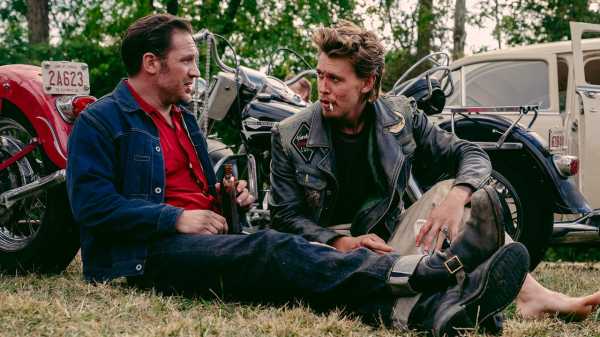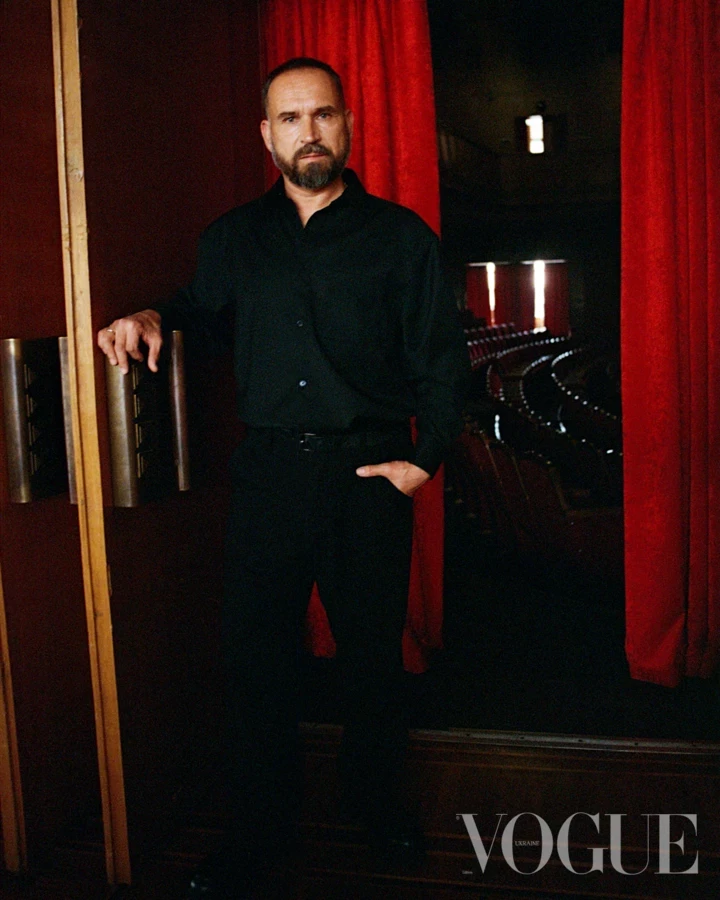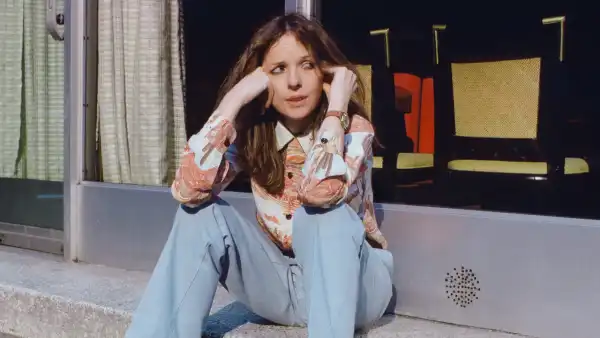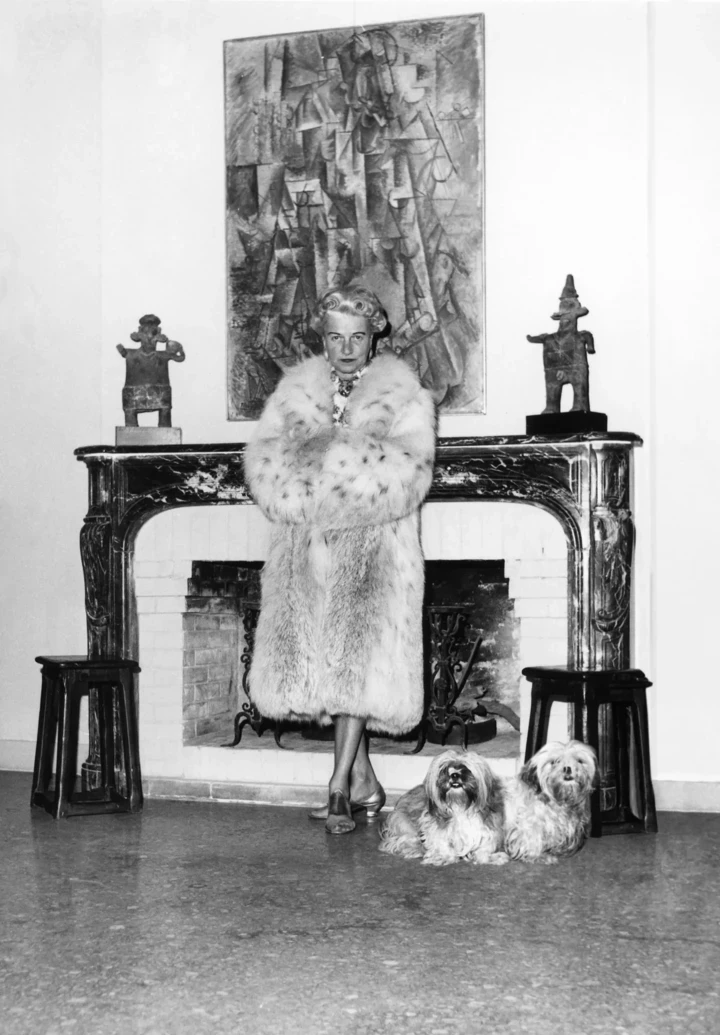
Save this storySave this storySave this storySave this story
Authenticity is a feeling and investigative fervor is an attitude. The Italian neorealist classics bear the marks of the journalistic research on which they rely, but journalists rarely feature in the action. The whole truth of even an instant is vast, and this is why, to get anywhere near it, fiction is created. In Jeff Nichols’s latest film, “The Bikeriders,” reportage is built into the story. It’s based on the photographer Danny Lyon’s 1968 book of the same title, which comprises pictures he took and interviews he conducted during four years that he spent with a Chicago motorcycle club, and, in the film, the character of Danny (Mike Faist) and his activities as a photographer and interviewer are a constant presence. This device lends “The Bikeriders” a tangy sense of contact with real life, but fidelity to facts ultimately proves limiting, and the movie as a whole feels underrealized.
Danny is one of two characters through whom Nichols, who wrote the script, tells the story. The other is a woman named Kathy (Jodie Comer), likewise based on a real person, whom Danny interviews onscreen over the course of many years. These interviews provide a dramatic framework and establish Danny and Kathy as the central consciousnesses of the film. The main characters, meanwhile, around whose exploits many of Kathy’s interviews revolve, are a pair of bikers in a club called the Vandals (in real life, the Outlaws): Johnny (Tom Hardy), the Vandals’ president, who keeps order with Machiavellian ferocity; and Kathy’s husband, Benny (Austin Butler), the club’s coolest member. Johnny, a family man who works as a truck driver, was inspired to form the club by seeing Marlon Brando in “The Wild One.” (Nichols even includes a clip of the famous exchange in which the biker Brando, asked what he’s rebelling against, responds, “Whaddya got?”) Benny, meanwhile, is more of a James Dean figure. Johnny tells him that he’s the person who the other members are trying to be. He’s someone whom everyone wants to follow, but he has no desire to lead.
The story of how Kathy and Benny got together—quaint and frightening in equal measure—is a prime example of how the fine-grained details of Lyon’s original interviews (clips of which are on his Web site) endow “The Bikeriders” with a transfixing power. Kathy finds herself in a bar frequented by the Vandals. She’s attracted from afar to Benny, who tries to chat her up, but she’s scared off by his companions’ rough looks and hardboiled manner, and leaves. The group follows her out and forces her to get on Benny’s bike, and then, as they drive on the open road, the Vandals come roaring up behind them. Benny gets Kathy home at 4 A.M., sparking trouble between her and her boyfriend. The next day, Benny parks in front of her house and refuses to leave. As Kathy says, “Five weeks later, I married him.”
As if adhering to the old journalism maxim “If it bleeds, it leads,” the movie opens not with this incipient romance but with a fight. Benny is sitting alone in a bar when two older tough guys order him to take off his Vandals jacket. He responds that they’ll have to kill him, and they take him more or less at his word, starting a brawl that spills onto the street. Then, just as a brutal—perhaps even fatal—injury is about to be inflicted, the frame freezes. The incident takes place midway through the chronology of the story, and the rest of the scene will play out later. This opening outburst is nonetheless no mere flash of sensationalism. Rather, it announces up front the main subject of “The Bikeriders”: violence, and the bikers’ dependence on it.
Kathy is overwhelmed by the bikers’ uninhibited energy, warmed by their essential camaraderie, and charmed by their boyishly flashy personalities. There is the laconic Cal (Boyd Holbrook); the modestly eccentric Cockroach (Emory Cohen), who likes to eat bugs but has an altogether more normative ambition, to become a motorcycle cop; the crudely wry Funny Sonny (Norman Reedus), whose grotesque affectations mask a jovial temperament; and Zipco (Michael Shannon), a tough and dour Latvian immigrant whose regressive world view Danny draws out of him. Zipco considers all college students “pinkos” and volunteered to fight in the Vietnam War but failed his psychological test. (Danny quietly challenges Zipco’s prejudices by declaring himself a college student.)
The bikers ride fast, daringly, and without regard to the rules of the road. (Early on, Benny outraces the police but gets arrested when he runs out of gas.) Kathy has no illusions about the volatility of the men she’s associating with, and, least of all, about Benny’s temperament; she’s well aware that he has the irresistible impulse to fight. But, as Kathy recognizes, to her own astonishment, these rebellious men, when they get together, behave according to a rigid set of rules. Constraint and discipline turn out to be as important to their sense of group identity as independence is; though they reject society’s rules, they are bound by their own and don’t hesitate to enforce them by means of violence.
Any member of the club is permitted to challenge Johnny for the presidency. The contest is not an election but a physical fight, and the challenger has his choice of fists or knives. Other club procedures and rites, which in another club might be dully bureaucratic, are, among the bikers, hair-raising trials. “Everyone wants to be part of something,” one of the Vandals says, and the Vandals are like a fraternity. For them the idea of one for all, all for one is no mere metaphor; rather, it’s a paramilitary code of honor. When one member is assaulted, the entire club takes revenge against both property (which Nichols displays with startling explicitness) and individuals (with deeds so appalling in their cruel design that the filmmaker gives them nothing but a one-line mention). And, when the Vandals are together in public, the police take pains to stay out of their way. Johnny arrogantly declares that the police are afraid of them.
One detail caught my eye: the Vandals all wear, on their jackets, a patch that says “1%.” One per cent of what, I wondered. The movie doesn’t make it clear, but apparently, among bikers, the idea is well known: when motorcycle clubs were being viewed throughout the country as threats to order, the American Motorcyclist Association is said to have declared that ninety-nine per cent of the motorcycling public was law-abiding. The Vandals proudly embrace this disreputable identity (as did the Outlaws). At the same time, the Vandals are men of principle—their lawbreaking and headbreaking have limits. The fundamental story of “The Bikeriders” is the erosion of this sense of principle and the degeneration of the Vandals. A clash of generations emerges. Unlike the older bikers, the young ones engage in violence that seems truly unhinged, and some of the veterans returning from Vietnam are even wilder and more reckless. The older Vandals’ ribald macho chivalry is replaced by overt predation and sexual violence. The result is that what had been a club becomes a gang. Kathy explains the distinction, saying that, for a gang, crime—drug dealing, robbery, even murder for hire—becomes a source of profit. The boyish toughness and the rebellious independence that made the Vandals appeal to Kathy bears the seeds of the group’s downfall.
Or so it seems. For all the fascinating anecdotal details that fill “The Bikeriders,” Nichols’s view of his biker protagonists remains swoony and impersonally mythologizing. The movie offers little insight into the characters’ lives apart from their boisterous adventures. Danny discloses almost nothing about himself, yet the real-life Lyon had been a biker since college at the University of Chicago and had also been, in 1962 and 1963, active in the civil-rights movement and a photographer for the Student Nonviolent Coordinating Committee. Lyon was a member of the Outlaws for two years, but, in the movie, the nature of Danny’s relationship with the Vandals goes unexplored. It’s the same for the group’s politics. Many of the Vandals wear the Iron Cross, but their opinions remain opaque—except for Zipco’s rant, which is presented as an unstrung outlier’s quirk. (Lyon, despite his politics, went along with wearing an Iron Cross, but, when another member used a Nazi flag as a picnic blanket, he spoke out.)
As for Kathy, she talks a lot about Benny but hardly at all about herself. Her voice is used in the film as a signifier of a woman’s point of view, but it’s not given the chance to actually deliver one. Kathy and Benny’s married life remains mainly out of sight, and there is almost nothing about Benny’s background, as if he turned up out of nowhere, with no past. Instead of exploring the realities of the bikers’ lives, “The Bikeriders” perpetuates and exalts their mythology, not by shrinking from facts about them but by shrinking from fiction. Nichols, with a wealth of factual information at hand, doesn’t seem to depart far from it. The information provided by Lyon is not so much raw material that gets developed as simply dead weight. This fear of fiction afflicts the performances, too, which, with the actors’ thick and chewy Chicago accents, often seem more like impersonations—albeit extremely skilled and dedicated ones. “The Bikeriders” displays the cost of noninterventionist direction, of sticking to source material with a self-inhibiting fidelity. These characters are still in search of their auteur. ♦
Sourse: newyorker.com







